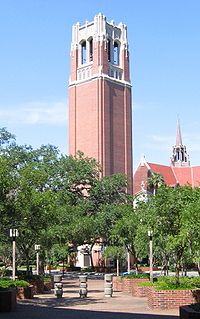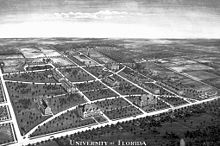The University of Florida is one of sixty-two elected member institutions of the Association of American Universities (AAU), the association of preeminent North American research universities, and the only AAU member university located in Florida. The University is classified as a Research University with Very High Research by the Carnegie Foundation for the Advancement of Teaching. Following the creation of performance standards by the Florida state legislature in 2013, the Florida Board of Governors designated the University of Florida as one of the two "preeminent universities" among the twelve universities of the State University System of Florida. In 2015, U.S. News & World Report ranked Florida as the fourteenth best public university in the United States.
The university is accredited by the Southern Association of Colleges and Schools (SACS). It is the third largest Florida university by student population, and is the eighth largest single-campus university in the United States with 49,913 students enrolled for the fall 2012 semester. The University of Florida is home to sixteen academic colleges and more than 150 research centers and institutes. It offers multiple graduate professional programs—including business administration, engineering, law, dentistry, medicine, and veterinary medicine—on one contiguous campus, and administers 123 master's degree programs and seventy-six doctoral degree programs in eighty-seven schools and departments.
The University of Florida's intercollegiate sports teams, commonly known by their "Florida Gators" nickname, compete in National Collegiate Athletic Association (NCAA) Division I and the Southeastern Conference (SEC). In their 108-year history, the university's varsity sports teams have won thirty-five national team championships, thirty of which are NCAA titles, and Gator athletes have won 275 individual national championships.
History
Main article: History of the University of Florida
Century Tower,
begun in 1953, to commemorate the 100th anniversary of the founding of
university and as a tribute to the alumni who perished in both World War I and World War II.
On January 6, 1853, Governor Thomas Brown signed a bill that provided public support for higher education in the state of Florida. Gilbert Kingsbury was the first person to take advantage of the legislation, and established the East Florida Seminary, which operated until the outbreak of the Civil War in 1861. The East Florida Seminary was the first state-supported institution of higher learning in Florida.
James Henry Roper, an educator from North Carolina and a state senator from Alachua County, had opened a school in Gainesville, the Gainesville Academy, in 1858. In 1866, Roper offered his land and school to the State of Florida in exchange for the relocation of the East Florida Seminary to Gainesville.
The second major precursor to the University of Florida was the Florida Agricultural College, established at Lake City by Jordan Probst in 1884. Florida Agricultural College became the state's first land-grant college under the Morrill Act. In 1903, the Florida Legislature, desiring to expand the school's outlook and curriculum beyond its agricultural and engineering origins, changed the name of Florida Agricultural College to the "University of Florida," a name that the school would hold for only two years.
"University of the State of Florida"
In 1905, the Florida Legislature passed the Buckman Act, which consolidated the existing publicly supported higher education institutions of the state. The member of the legislature who wrote the act, Henry Holland Buckman, later became the namesake of Buckman Hall, one of the university's oldest buildings. The Buckman Act organized the State University System of Florida and created the Florida Board of Control to govern the system. The act abolished the six pre-existing state-supported institutions of higher education, and consolidated the assets and academic programs of four of them to form the new "University of the State of Florida." The four predecessor institutions consolidated to form the new university included the University of Florida at Lake City (formerly Florida Agricultural College) in Lake City, the East Florida Seminary in Gainesville, the St. Petersburg Normal and Industrial School in St. Petersburg, and the South Florida Military College in Bartow.The Buckman Act also consolidated the colleges and schools into three institutions segregated by race and gender—the University of the State of Florida for white men, the Florida Female College for white women, and the State Normal School for Colored Students for African-American men and women.
The City of Gainesville, led by its Mayor William Reuben Thomas, campaigned to be home to the new university. On July 6, 1905, the Board of Control selected Gainesville for the new university campus. Andrew Sledd, president of the pre-existing University of Florida at Lake City, was selected to be the first president of the new University of the State of Florida. The 1905-1906 academic year was a year of transition; the new University of the State of Florida was legally created, but operated on the campus of the old University of Florida in Lake City until the first buildings on the new campus in Gainesville were completed. Architect William A. Edwards designed the first official campus buildings in the Collegiate Gothic style. Classes began on the new Gainesville campus on September 26, 1906, with 102 students enrolled.
In 1909, the name of the school was officially simplified from the "University of the State of Florida" to the "University of Florida."
The alligator was incidentally chosen as the school mascot in 1911, after a local vendor ordered and sold school pennants with an alligator emblem imprinted on them. The school colors, orange and blue, are believed to be derived from the blue and white school colors of the Florida Agricultural College in Lake City and the orange and black colors of the East Florida Seminary at Gainesville.
Statue of Albert Murphree, the second president of the university.
College reorganization
In 1909, Albert Murphree was appointed the second president of the university, and organized several of the colleges of the university, increased enrollment from under 200 to over 2,000, and he was instrumental in the founding of the Florida Blue Key leadership society. Murphree is the only University of Florida president honored with a statue on the campus.
The University of Florida campus in 1916, looking southwest.
John J. Tigert became the third university president in 1928. Disgusted by the under-the-table payments being made by universities to athletes, Tigert established the grant-in-aid athletic scholarship program in the early 1930s, which was the genesis of the modern athletic scholarship plan that is currently used by the National Collegiate Athletic Association.
Post World War II
Beginning in 1946, there was dramatically increased interest among male applicants who wanted to attend the University of Florida, mostly returning World War II veterans who could attend college under the GI Bill of Rights (Servicemen's Readjustment Act). Unable to immediately accommodate this increased demand, the Florida Board of Control opened the Tallahassee Branch of the University of Florida on the campus of Florida State College for Women in Tallahassee.By the end of the 1946–47 school year, 954 men were enrolled at the Tallahassee Branch. The following semester, the Florida Legislature returned the Florida State College for Women to coeducational status and renamed it Florida State University. This sequence of events also opened up all of the colleges that comprise the University of Florida to female students. African-American students were allowed to enroll starting in 1958. Shands Hospital first opened in 1958 along with the University of Florida College of Medicine to join the already established College of Pharmacy. Rapid campus expansion began in the 1950s and continues to the present day.The University of Florida is one of two Florida public universities, along with Florida State University, to be designated as a "preeminent university" by Florida senate bill 1076, enacted by the Florida legislature and signed into law by the governor in 2013. As a result of this legislation, the preeminent universities now receive additional funding that is intended to improve the academics and national reputation of higher education within the state of Florida.



कोई टिप्पणी नहीं:
एक टिप्पणी भेजें